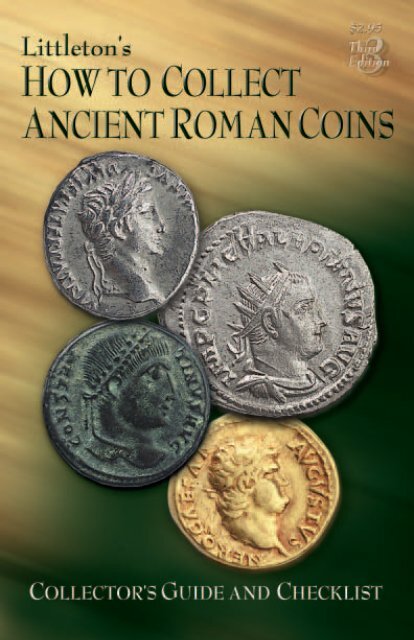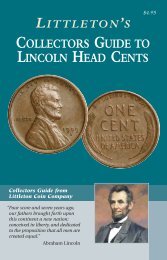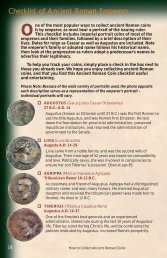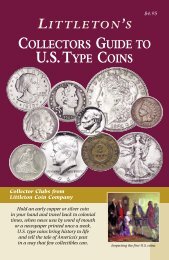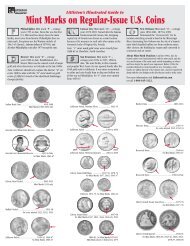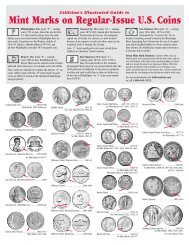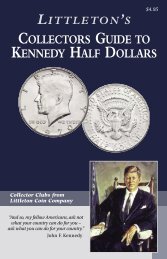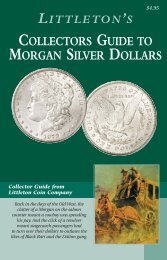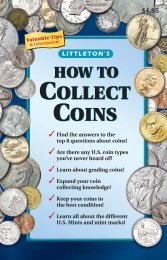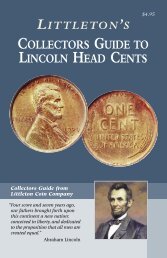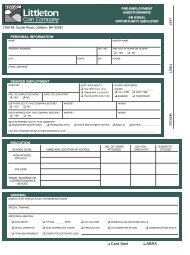Ancient Coins 8/13 - Littleton Coin Company
Ancient Coins 8/13 - Littleton Coin Company
Ancient Coins 8/13 - Littleton Coin Company
You also want an ePaper? Increase the reach of your titles
YUMPU automatically turns print PDFs into web optimized ePapers that Google loves.
IntroductionDear Collector,Collecting ancient coins can be bothawe-inspiring and exciting. Imagine owninga coin struck before the time of Christand actually holding it in your hand,instead of looking at it in a museumcase. You have an object that’s familiar,but centuries older!Yet, forming a collection of those samecoins can be daunting, especially ifyou’re just entering the field of ancientnumismatics. That’s why we developed thisDavid M. SundmanPresident, <strong>Littleton</strong> <strong>Coin</strong> Co.handy guide and checklist over 5 years ago. It has beenused at the ANA Summer Seminars, given to collectors inthe field, and will help you build your own collection.In this new, expanded 3rd edition of How to Collect<strong>Ancient</strong> Roman <strong><strong>Coin</strong>s</strong>, you’ll find:• 25 new Imperial portrait coins of emperorsand their wives• Provincial (Greek Imperial) coinage sectionwith photos• information on portrait and non-portrait coins• coins of Julius Caesar, Marc Antony and Cleopatra• an updated glossaryTo further your enjoyment, this 48-page booklet contains abiography of each emperor listed.Most collectors choose to begin with Roman Imperialcoins. One of the wonderful features of Imperial coins isthat they bear the portraits of the emperors who issuedthem over 1,500 years ago. In fact, some rulers are onlyknown to us today because of their portrait coins, andsometimes these coins provide archaeologists with a meansof dating a site.The collecting of ancient coins has been going on fornearly as long as coins have been in existence. Alexanderthe Great gave coins to his friends, and Augustus collectedthem. As you build your collection of ancient Roman coins,you’ll enjoy an amazing variety of portraits spanning morethan 500 years, and uncover the incredible stories of themen and women that they portray!Happy collecting,David M. SundmanProfessional Numismatists Guild member #5102 How to Collect <strong>Ancient</strong> Roman <strong><strong>Coin</strong>s</strong>
TABLE OF CONTENTSIntroduction ........................................................................210 Often-Asked Questions About <strong>Ancient</strong> <strong><strong>Coin</strong>s</strong> ........4Denominations of Roman <strong><strong>Coin</strong>s</strong> ......................................6How to Read <strong>Ancient</strong> Roman <strong>Coin</strong> Inscriptions ..........8Provincial <strong>Coin</strong>age ............................................................10Julius Caesar, Marc Antony & Cleopatra......................12Checklist of <strong>Ancient</strong> Roman Emperors ........................14Reference List....................................................................40A Short Glossary of Roman Terms ..............................42Bits & Pieces ....................................................................44Roman Imperial coinage shown on cover:Silver Denarius of Augustus –could this have been the legendary tributepenny spoken of in the Bible? “…Render untoCaesar the things that are Caesar’s and untoGod the things that are God’s.” (Mark 12:15-16)Gold Aureus of Nero –a scarce, historically significant coin. Struckafter a plot to murder this depraved emperorwas discovered.Silver Antoninianus of Valerian I –the only emperor taken alive – the ultimatedisgrace. Forced to kneel as a mountingblock and footstool for his captor, Shapur I,king of Persia.Bronze <strong>Coin</strong> of Constantine the Great –one of Rome’s greatest emperors, whocelebrated a successful reign with renewalof his vows (vota) to the gods.3
10 Often-Asked Questions About <strong>Ancient</strong> <strong><strong>Coin</strong>s</strong>IIIIIIIVVHow do you know if coins are authentic?<strong>Ancient</strong>s have been studied and collected throughout the world for manycenturies. Expertise in this field has been developed over a long period oftime. All ancient coins offered by <strong>Littleton</strong> have been carefully examined byour experts and are guaranteed genuine.How can some ancient coins beso inexpensive?<strong>Ancient</strong> civilizations issued coins from about650 B.C. to A.D. 500, a span of 1,200 years, whichis six times as long as the history of the UnitedStates. And there were hundreds of mintsspread over a much larger area. Since therewere no banks, coins were usually hiddenunderground – and for various reasons,many were never retrieved. Numeroushoards have been found in lands of formerancient empires, especially since theadvent of the metal detector. Expertsestimate that one half of 1% of ancientssurvive today, which still adds up toa considerable number. Because the numberof ancient coin collectors is still relativelysmall, demand is fairly limited.Who grades the coins and bywhat standards?<strong>Ancient</strong> coins offered by <strong>Littleton</strong> are obtained from leading specialists in thefield. They are then graded by our in-house experts following standards forancient coins. This method differs from grading of modern issues due to thenature of coin blanks, minting processes, compositions and age. <strong>Ancient</strong> coinblanks were usually uniform in weight but irregular in shape. Because mostwere hand struck using dies and hammers, centering of the design andquality of the strike are factors in grading. In addition, the metals used andthe aging process (up to 2,000 years or more) affect the appearance andfinish of the coins in all grades – so grading standards are unique forindividual issues.How are the coins acquired?<strong>Littleton</strong> obtains ancient coins from leading specialists throughout the world.All coins have been legally imported into the U.S. following all applicablelaws and regulations.Have the coins been cleaned?Unlike modern issues, it is usually necessary for experts to clean ancientcoins. As most are found in buried hoards, nearly all have been cleaned, evenrarities worth thousands of dollars. Our experts clean the ancients we offerusing a variety of techniques employed by world-class museums and leadingcoin authorities. <strong><strong>Coin</strong>s</strong> should never be cleaned except by experts.4 How to Collect <strong>Ancient</strong> Roman <strong><strong>Coin</strong>s</strong>
VIVIIVIIIIXXHow were ancient coins minted?The earliest Roman coins and some Biblical issueswere cast (molten metal poured into molds andallowed to harden). <strong>Ancient</strong> Roman coins were castuntil about 211 B.C., then all issues were struck usinghand-held dies and hammers. The design of one sidewas carved into a metal disk or die which fit into ananvil, and the design of the other side was carved intothe base of a metal punch. A coin blank was placed onthe die in the anvil, and the punch was placed over it.With one or more sharp blows of a hammer, a coin wasmade (as a result, ancients are sometimes weaklystruck, off center or double struck).What sizes and denominations are the coins?While ancients can range in diameter from the size of a pea to the size ofa silver dollar, there were general size standards for variousdenominations. Among the most familiar ancient Greek coins are thestater, drachm and tetradrachm (equal to four drachms). The mostfamiliar ancient Roman silver coin for centuries was the denarius, whichwas followed and replaced by the antoninianus.What is on the reverse of the coins?The earliest Greek coins are uniface (a design only on one side with apunch-mark reverse), but most depict mythological figures and imageson both sides. The obverse or “heads” side of most ancient Roman coinspictures the ruling emperor at the time of striking. The reverse usuallydepicts deities, mythological figures or symbols of the rulers’ authority.What coins are classified as ancient?The earliest coins are attributed to Lydia in Asia Minor about600-700 B.C., but coins may have been used earlier in China. The term“ancient” usually applies to coins from the earliest known issues to thosestruck during the first five centuries A.D., about 1200 years of coinage.How popular is ancient coin collecting?While U.S. coin collecting has grown in popularity since the 1850s,ancient coin collecting has been a popular hobby worldwide for manycenturies. European monarchs and even popes have assembledimpressive collections since medieval times (and ancient coin referencebooks date back to the 1500s). Because ancients are the basis for allmodern coinage, it is an important area of numismatics. There areenthusiasts in every country, yet the overall number of ancient coincollectors is still somewhat limited. It’s estimated that fewer than100,000 people actively collect ancients today. Though most collectorschoose coins based on obverse designs, some enjoy collecting thevarious reverse designs. While it is possible to collect coins from nearlyall of the Roman emperors, some are difficult to find because theemperors ruled for such a short time. Usurpers and self-proclaimedrulers also struck coins, and many of these are quite rare.5
Denominations of <strong>Ancient</strong> Roman <strong><strong>Coin</strong>s</strong>Like coinage of today, <strong>Ancient</strong> Rome’s coinsrepresented portions of larger denominations.The as,the basic unit, functioned like our penny.And like our penny, through inflation it experienced aloss of buying power. During the time of the RomanRepublic, you could buy a loaf of bread for 1 ⁄2 as or aliter of wine for one as.A year’s pay for acommander in the Roman army around <strong>13</strong>3 B.C. was10 2 ⁄3 asses,by Augustus’ rule (27 B.C.-A.D. 14)74 denarii, and by the reign of Septimus Severus(A.D. 193-211), it rose to 1,500 denarii.Below is a brief description of nine of the mostcommon denominations issued in the <strong>Ancient</strong>Roman Empire.1 As = a “whole” or “one” unit2 Asses = 1 Dupondius4 Asses = 1 Sestertius16 Asses = 1 silver Denarius8 Dupondii = 1 Denarius4 Sestertii = 1 Denarius1 Antoninianus = 2 Denarii1 Aureus = 25 DenariiAS: Initially, the as was cast in bronze. Later, withreduction in weight, it was small enough to be struck withcoin dies. With Augustus’ coinage reforms in 23 B.C., thiscoin was struck in copper and showed the emperor with abare or laureated head. By the rule of Valerian and his sonGallienus in the middle of the 3rd century, the as wasinfrequently struck.DUPONDIUS: Worth two asses; literally means “two-pounder,”but even during the Roman Republic it didn’t weigh2 pounds. Though this brass coin was more yellow in color, itwas still easily confused with the as. Under Nero, theemperor, it began to show an emperor with a radiate crown.SESTERTIUS: Originally a small silver coin issued around211 B.C., the sestertius was worth 2 1 ⁄2 asses. Under Augustus itbecame a large “golden” orichalcum (brass) coin, worth 4asses. Its large size allowed emperors to commemorate victories,triumphs or virtues as rulers. By the 3rd century A.D., thesestertius had become a smaller bronze coin, and afterGallienus’ reign (A.D. 253-268), it was no longer minted.6 How to Collect <strong>Ancient</strong> Roman <strong><strong>Coin</strong>s</strong>
FOLLIS “Nummus”: Emperor Diocletian first minted the follis, abronze coin with a minute amount of silver (usually a wash),around A.D. 294. Because of the chaotic state of the Empire,it rapidly underwent changes, decreasing in size and weight.REDUCED FOLLIS: Through time, economic changes forced areduction in size and weight of the bronze follis. It was graduallyreduced under Constantine, and eventually replaced after the endof the Constantinian Era.DENARIUS: This standard silver coin of the Roman Empire depictedan emperor wearing a laurel wreath. First issued around211 B.C., it started with 5% alloy, and over the years the alloy wasincreased, until by the reign of Septimius Severus it reached 45%.The denarius disappeared from circulation around the time ofGordian III (A.D. 238-244).ANTONINIANUS “Double Denarius”: Caracalla first minted theantoninianus around A.D. 211. It is named for him:M. Aurelius Antoninus “Caracalla.” This silver coin shows theemperor wearing a “radiate crown” as opposed to the laurelwreath of the denarius. Starting with 40% silver, this coinwas gradually debased to a silver wash. Finally, it was abolishedduring the reign of Constantine the Great (A.D. 307-337).SILIQUA: A small silver coin first issued by Diocletian, originallycalled the argenteus. Later reintroduced as a siliqua underConstantine the Great, this coin weighed 1/96th of a Romanpound, but its exact place in the monetary system and its value arenot known.AUREUS “Golden”: Standard gold coin of the Roman Empire. Firstissued regularly under Julius Caesar around 46 B.C. Although itwas reduced in weight, through time, the gold content remainedconsistently high. The aureus circulated until A.D. 309 whenConstantine the Great replaced it.SOLIDUS: Gold coin minted by Constantine the Great, replacing andweighing less than the aureus. This coin, later struck by theByzantines, endured for seven centuries as a circulating goldcoin used for commerce in Europe.To assist the reader in coin identification, every efforthas been made to present actual-size photographs.7
How to Read <strong>Ancient</strong> Roman <strong>Coin</strong> InscriptionsDOMITCAESAVGIMPGERMPMTRP XVIMPCAESDOMITAVGGERMImperator (victoriousgeneral), received uponaccessionCaesar. Inherited nameof the Julian family(Julius Caesar). Usedby later emperors todesignate heir.Domitianus, ruler’sname.Augustus, title of theemperor.Germanicus, a titlehonoring militaryvictories in Germany.Silver Denarius portrait coin of DomitianWhile not entirely realistic, coin portraits visually identified theemperor. The inscription not only named the current ruler, butalso proclaimed the legitimacy of his authority.Crowns were originally a mark of honor for those whohad distinguished themselves in battle. The crownworn on imperial coins is one of the many ways ofidentifying the denomination and possible date of issue.PMTRP XVPontifex Maximus.Highest priest. Thehead of state religion.Tribunica Potestate.Tribune of the people.Each renewal indicatedby numerals.Laureate: Emperor wears a wreath of laurel,oak or ivy branches. Most common crown infirst 350 years. It frequently distinguishessingle denominations.Radiate: Spiky crown associated with sun-god Sol,primarily used on double denomination coinslike Antoninianus and Dupondius (after A.D. 64).Diadem: A band of metal or cloth, oftendecorated, used extensively starting withConstantine the Great.8 How to Collect <strong>Ancient</strong> Roman <strong><strong>Coin</strong>s</strong>
CLAVDIVSTICLAVDIVSCAESARAVGTiberiusClaudius, ruler’sname.Caesar. Inheritedname of the Julianfamily (JuliusCaesar). Used bylater emperors todesignate heir.Augustus, title of theemperor.TICAESARObverse DesignModiusTraditional Roman grainmeasure symbolizingimperial generosity.AVGBronze Quadrans non-portrait coin of Claudius<strong><strong>Coin</strong>s</strong> without portraits were issued in various denominations by theRoman emperors. These non-portrait coins might have commemorateda family member, founding of a city or important event. Most bear thename of the issuing emperor.Augustus Bronze coin of PhilippiIssued under Augustus. Victory on theobverse with legionary standards on thereverse. Possibly refers to Battle of Actiumand settlement of veterans.Bronze Prutah of Antonius Felix,procurator of Judea under ClaudiusA.D. 52-59Portrait coins of Britannicusare extremely rare, yet thiscoin bears his abbreviated namein Greek, and is very affordable.BPIT = BRITANNICUS9
Provincial <strong>Coin</strong>ageImperial portrait issues ofMacrinus are hard to findand expensive, but thisProvincial issue makes anaffordable alternative.As Rome spread its influenceand consolidated power,lands once held by barbariantribes, independent city-states,and Hellenistic kingdoms fellunder its authority. Becausethe Romans left local systemslike religion, rulers and coinagein place, those areas allproduced their own coins.These local coins, once struck in over 500cities, could circulate within a single city oracross a region.Today, these coins make up the groupknown as Provincial coinage, which somecollectors call Greek Imperials. Provincialcoinage now offers an affordable wayto collect coinage of emperors whoseImperial issues are both rareand expensive.Legends can be in Greek or Latin, or both!Because many areas once were part of the empire ofGreece’s illustrious king Alexander the Great, theircitizens considered themselves Greek and spoke thelanguage. So these Provincial coins can have legends ineither Greek or Latin, or sometimes both.Provincial coinage has several features that make itvery different from Roman Imperial coinage. UnlikeRoman Imperial coinage, which was issued regularlyand had fixed denominations like the as, sestertius ordenarius, Provincial coinage was issued sporadically witha wide variety of values followingNero silver Tetradrachmof Antioch, A.D. 63/64Emperor’s name & title in GreekNEROCAESAREagle ReverseGreek denominations.At the empire’s beginnings,mints in both the east and weststruck coins for their own locales.But by the reign of Claudius,A.D. 41-54, as Roman Imperialissues spread, westernProvincial coinage ceased.Eastern mints continued foranother 200 years because aminting tradition passed downfrom Alexander the Great’ssuccessors was already in place.10 How to Collect <strong>Ancient</strong> Roman <strong><strong>Coin</strong>s</strong>
Provincial bronze coin ofCarinus struck at Alexandriafor circulation in EgyptAntioch, Tyre and Alexandria – three important Provincial mintsThree of the greatest eastern mints wereAntioch and Tyre in Syria, and Alexandria inEgypt. The Syrian mints produced the famouscoins mentioned in the Bible, like the silvertetradrachms with various emperors’portraits, and Tyrian shekels. By A.D. 60,Antioch had absorbed Tyre’s coinage, andcontinued to strike coins until the reign ofTrebonianus Gallus.Provincial bronze ofAugustus celebratesrefounding of aRoman colonyFounded by Alexander the Great, the mint atAlexandria, Egypt outlasted all other provincial mints. WhenAugustus defeated Antony and Cleopatra at Actium, Egyptbecame the personal property of the emperor. This richcountry served as the “breadbasket” of Rome, and already hada coinage system that was “closed.” Under this closed system,coins were struck and circulated only in Egypt. Futureemperors maintained this system until Diocletian’s reformsof A.D. 294. At that time, all Provincial coinage ended, andwas replaced by Imperial issues.The Shekel of Tyre could have been the“thirty pieces of silver” paid to Judasfor Christ’s betrayal. Struck from126 B.C.-A.D. 58/59 in Tyre. Later,Rome moved all minting to Antioch.AntiochLocation of the 3 mostimportant easternProvincial mintsTyreAlexandria11
Julius Caesar, Marc Antony & CleopatraPre-Imperial <strong>Coin</strong>ageThe coins struck between the death of the dictator Sulla,78 B.C., and the rise of Octavian (future Augustus) aretransitional coinage, connecting the Republican andImperial eras. During this time, bold generals raised hugearmies, striving for the ultimate prize – power.Three rulers stand out amid the turmoil – two men and awoman whose power was so great and stories so compellingthat today they seem almost legendary: Julius Caesar, MarcAntony and Cleopatra.Julius Caesar, 60-44 B.C.General, reformer and dictator… One man, Julius Caesar,rose from the chaos and brought an interval of stability,setting the Roman world on the road to imperial rule.When Caesar crossed theRubicon, marched on Rome anddrove the great general Pompey intoGreece, he financed this invasionand secured the loyalty of his troopsby striking silver denarii. Thesehistoric Roman coins have his nameand an elephant trampling a snakeon the obverse. Many numismatistsbelieve the snake represents Salus,god of safety, and the elephantrepresents Pompey. After Pompey’sdefeat, Caesar was appointed tothe office of dictator, renewedannually. He was assassinated onMarch 15, 44 B.C.Death of CaesarSilver Denariusof Julius Caesar,49-48 B.C.Rare bronze portraitcoin of Julius Caesar12 How to Collect <strong>Ancient</strong> Roman <strong><strong>Coin</strong>s</strong>
Marc Antony, 44-33 B.C.Antony served with Julius Caesar in Gauland later became co-consul in 44 B.C.At Caesar’s death, he joined forces withOctavian. In 42 B.C. on a campaignto reorganize the east, he met theEgyptian queen, Cleopatra. WhenAntony married Cleopatra, his strainedalliance with Octavian became a strugglefor world dominance.In 31 B.C. Octavian declared war onCleopatra, culminating in the Battle ofActium. Although Antony and Cleopatrawere defeated, the silver denarii Antonyissued to pay his soldiers still exist.Silver LegionaryDenarius of MarcAntony, 32-31 B.C.Bronze coin of Antonyand Cleopatra,32-31 B.C.(©2001 <strong>Ancient</strong> Art & Architecture Collection)Cleopatra, 51-30 B.C.When ancient Rome was still abackwater town, Alexandria was thecultural center of the ancient world,and Cleopatra was queen. WhileCaesar was busy conquering Gaul,Cleopatra was ruling Egypt with herbrother. More than a match forRome’s greatest military minds, thishighly educated, politically astutewoman became Caesar’s mistress andMarc Antony’s wife. After defeat at Actium,Cleopatra and her maids were found deadin their apartments. Contrary to thepopular asp bite story, many historiansbelieved they took poison.Battle at ActiumEgyptian bronzeportrait coin ofCleopatra, last ofthe Ptolemies<strong>13</strong>
Checklist of <strong>Ancient</strong> Roman EmperorsOne of the most popular ways to collect ancient Roman coinsis by emperor, as most bear a portrait of the issuing ruler.This checklist includes imperial portrait coins of most of theemperors and their families, followed by a brief description of theirlives. Dates for reign as Caesar as well as Augustus are included. Notethe emperor’s family or adopted name follows his historical name,then look at the progression as rulers adopt a predecessor’s names toadvertise their legitimacy.To help you track your coins, simply place a check in the box next tothose you already own. We hope you enjoy collecting ancient Romancoins, and that you find this <strong>Ancient</strong> Roman <strong>Coin</strong> checklist usefuland entertaining.Please Note: Because of the wide variety of portraits used, the photo oppositeeach description serves as a representation of the emperor’s portrait –individual portraits will vary.AUGUSTUS (Gaius Julius Caesar Octavianus)27 B.C.-A.D. 14Augustus (known as Octavian until 27 B.C.) was the first Roman touse the title Augustus, and was Rome’s first Emperor. He laiddown the foundation for provincial administration, preservedrepublican institutions, and returned the administration ofgovernment to the Senate.LIVIA (Livia Drusilla)Augusta A.D. 14-29Livia came from a noble family, and was the second wife ofAugustus. Their marriage of 52 years was based on compatibilityand love. Politically savvy, she was involved in conspiracies toensure her son Tiberius’ succession. Died at age 85.AGRIPPA (Marcus Vipsanius Agrippa)Tribunician Power 18-12 B.C.As classmate and friend of Augustus, Agrippa had a distinguishedmilitary career and won many honors. He married Augustus’daughter and received the tribunician power (was made heir tothrone). He died in 12 B.C.TIBERIUS (Tiberius Claudius Nero)Augustus A.D. 14-37One of the Empire’s best generals and an experiencedadministrator, shared rule during the last 10 years of Augustus’life. Tiberius ruled during Christ’s life, and by continuing thepolicies instituted by Augustus, increased Rome’s prosperity.14 How to Collect <strong>Ancient</strong> Roman <strong><strong>Coin</strong>s</strong>
DRUSUS (Drusus Julius Caesar)Born 14 B.C./Died A.D. 23Son of Tiberius, who eventually received the tribunician power.Compared to his father, he was inferior in almost every way. Hewas poisoned by his wife and her lover, Sejanus (praetorianprefect of Tiberius).NERO CLAUDIUS DRUSUS (Drusus the Elder)Born 38 B.C./Died 9 B.C.Brother of Emperor Tiberius. One of the greatest heroes ofhis time. After becoming general of the armies in Germany,he had outstanding success. Married Marc Antony’syoungest daughter Antonia. When he died, the Senate gavehim the surname Germanicus.GERMANICUS (Germanicus Julius Caesar)Born 15 B.C./Died A.D. 19Son of Nero Claudius Drusus and very popular with the Romanlegions. They wanted him to fight for the rule of the Empire, butGermanicus remained loyal. He was nephew of Tiberius, whomade him Caesar in A.D. 4. While overseeing the succession tothe throne in Antioch, he was poisoned.NERO CAESAR (Nero Julius Caesar)(Born A.D. 7/Died A.D. 30/31)and DRUSUS CAESAR (Drusus Julius Caesar)(Born A.D. 8/Died A.D. 33)Sons of Germanicus and Agrippina. Nero was highly educatedand outstanding in character, the opposite of his brother,Drusus. He fell victim to a plot by Sejanus and Drusus, and wasexiled to an island where he died.Drusus helped plot his brother’s downfall, but became avictim of political intrigue, too. He was arrested and diedin prison.CALIGULA (Gaius Julius Caesar Germanicus)Caesar A.D. 35-37Augustus A.D. 37-41Youngest son of Germanicus and Agrippina, and brother to Neroand Drusus Caesar. He was given the nickname “Caligula” bysoldiers because as a young boy he wore a small soldier’suniform along with the half-boot (caliga). Caligula (or “Bootsie”)became emperor after smothering Tiberius. He soon becameexcessively cruel and was murdered by a group of praetorians.To assist the reader in coin identification, every efforthas been made to present actual-size photographs.15
TITUS (Titus Flavius Vespasianus)Caesar A.D. 69-79Augustus A.D. 79-81Elder son of Vespasian, who is best known for his campaigns inJudea. He was a good ruler, who looked after the welfareof his people. His brother, Domitian, was thought to havepoisoned him.DOMITIAN (Titus Flavius Domitianus)Caesar A.D. 69-81Augustus A.D. 81-96Domitian, youngest son of Vespasian, followed Augustus’ style inruling the Empire, but was unpopular with the senate and upperclass. He became very suspicious and cruel, and was eventuallykilled by members of his household.NERVA (Marcus Cocceius Nerva)Augustus A.D. 96-98One of the “good” emperors, Nerva tended to the poor,reorganized the Empire’s finances, and brought peacefulrelationships into existence between the army and Senate.TRAJAN (Marcus Ulpius Trajanus)Caesar A.D. 97Augustus A.D. 98-117Trajan was popular with the army and Senate. Under his rule, theRoman Empire reached its largest size. Many public works wereundertaken during his reign.HADRIAN (Publius Aelius Hadrianus)Augustus A.D. 117-<strong>13</strong>8Hadrian was adopted by Trajan and continued his governmentalpolicies. Hadrian’s Wall in Britain is one of the many fortificationshe ordered to protect the Empire’s frontiers.SABINA (Vibia Sabina)Augusta A.D. 128?-<strong>13</strong>6Entered an arranged marriage with Hadrian long before hebecame emperor. Contemporary history paints their 36 years ofmarriage as unhappy, but Sabina accompanied Hadrian on mostof his journeys throughout the empire.AELIUS (Lucius Aelius Verus [Vagi])Caesar A.D. <strong>13</strong>6-<strong>13</strong>8Adopted by Hadrian, stories about his character vary. Some sayhe was unfit to rule, and others say he was competent and fair.Aelius’ weak and unhealthy constitution caused his death.17
Checklist of <strong>Ancient</strong> Roman EmperorsANTONINUS PIUS(Titus Aurelius Fulvus Boionius Arrius Antoninus)Caesar A.D. <strong>13</strong>8Augustus A.D. <strong>13</strong>8-161Adopted by Hadrian, and in turn adopted his nephew MarcusAurelius to succeed him as emperor. He had a peaceful reign inwhich the economy flourished.FAUSTINA SR. (Annia Galeria Faustina)Augusta A.D. <strong>13</strong>8-140/1From a wealthy and noble Spanish family, Faustina Seniormarried Antoninus Pius about A.D. 110. Although they had fourchildren, only Faustina Jr. survived. Three years after Antoninusbecame emperor, Faustina Sr. died and was deified on a vastnumber of Imperial coins.MARCUS AURELIUS (Marcus Annius Verus)Caesar A.D. <strong>13</strong>9-161Augustus A.D. 161-180Continued Rome’s prosperity, but had border problems with thebarbarians. A careful, moral ruler whose writing survived andshowed that he should have been a philosopher instead ofemperor. As promised, he raised Lucius Verus to co-emperor.FAUSTINA JR. (Annia Galeria Faustina)Augusta A.D. 147-175/6Faustina became the first daughter of an emperor to marry anemperor, give birth to a future emperor, and die naturally.<strong>Ancient</strong> historians accuse her of numerous infidelities. Shetravelled extensively with her husband Marcus Aurelius, andearned the title Mater Castrorum (mother of the camps).LUCIUS VERUS (Lucius Aelius Aurelius Commodus)Augustus A.D. 161-169Lucius became “Colleague in the Principate” in A.D. 161. Hewas almost the opposite of Marcus Aurelius in character.He died in A.D. 169 while returning to Rome from battlesin Dacia.LUCILLA (Annia Aurelia Galeria Lucilla)Augusta A.D. 164-182/3The daughter of Marcus Aurelius, wed at 16 to co-emperor LuciusVerus. Widowed at 20, her father carefully selected a respected,older senator as her next husband. When her involvement in aplot to murder her brother and emperor Commodus wasexposed, she was exiled and put to death.18 How to Collect <strong>Ancient</strong> Roman <strong><strong>Coin</strong>s</strong>
COMMODUS (Lucius Aelius Aurelius Commodus)Caesar A.D. 166-177Augustus A.D. 177-192Made Augustus and co-emperor in A.D. 177. When MarcusAurelius’ son Commodus came to rule, the peaceful era thathad existed from Galba to Aurelius ended. Later in life,Commodus was probably insane. He believed he was thereincarnation of Hercules.CRISPINA (Bruttia Crispina)Augusta A.D. 177-182/3Married Commodus in A.D. 177, the year he became emperor.According to contemporary historians, she was exceptionallybeautiful. As Commodus’ insanity progressed, she supposedlyengaged in many affairs, resulting in banishment and death. Now,it is believed she took part in an assassination attempt.DIDIUS JULIANUS (Marcus Didius Severus Julianus)Augustus A.D. 193One of three emperors who ruled during a 6-month span. Didiusbought the office of emperor during an auction, thereby offendingRome’s citizens. They appealed to the frontier generals to rescuethem. He was beheaded, a fate usually reserved for commoncriminals. Ruled for 66 days.PESCENNIUS NIGER (Gaius Pescennius Niger)Augustus A.D. 193-194After a long military career, Pescennius became governor of Syria.When Pertinax was murdered, Pescennius’ troops proclaimed himemperor. Although he was one of the generals Rome’s citizensappealed to, word reached him too late and he was killed less thana year later.CLODIUS ALBINUS (Decimus Clodius Septimius Albinus)Caesar A.D. 193-195Augustus A.D. 195-197Coming from a military family, Clodius was well educated ingeography. Became Caesar under Septimius Severus, laterproclaimed emperor by his troops. Lost his life after Septimiusdefeated an eastern rival and returned to defeat him.SEPTIMIUS SEVERUS (Lucius Septimius Severus)Augustus A.D. 193-211Became emperor after defeating both of his rivalsPescennius Niger and Clodius Albinus. Adopted a military-stylegovernment, while paying little attention to the Senate.19
Checklist of <strong>Ancient</strong> Roman EmperorsJULIA DOMNA (Julia Domna)Augusta A.D. 193-217A woman of beauty, intelligence and wit, Julia Domna wasmatriarch of the Severan dynasty. Her staunch refusal to allowthe empire to be divided between her sons was her greatest feat.She was so well respected that she retained the title of Augustaeven after her sons died.CARACALLA (Marcus Aurelius Antoninus)Caesar A.D. 195-198Augustus A.D. 198-217Elder son of Septimius and brother of Geta. His nickname,Caracalla, came from the Gallic coat he wore. He convinced thePraetorian Guard to murder his brother. Known for hisextravagances and cruelties, he was murdered by hispraetorian prefect. “Caracalla’s Baths” in Rome still exist.PLAUTILLA (Publia Fulvia Plautilla)Augusta A.D. 202-205Caracalla and Plautilla’s marriage was based on politicalnecessity, not love. Supposedly, they loathed each other so muchthat they wouldn’t even dine together. Eventually, Caracalladivorced, exiled and murdered her.GETA (Lucius Septimius Geta)Caesar A.D. 198-209Augustus A.D. 209-211Younger son of Septimius, was popular with the military andco-ruled with his brother, Caracalla. But at the age of 23, Getawas murdered under the direction of his cruel brother.MACRINUS (Marcus Opellius Macrinus)Augustus A.D. 217-218Became involved in Caracalla’s death in order to save his ownlife. Later, the army killed him and his young son because of anunfavorable peace made with the Parthians and mutiny broughtabout by the grandmother of future emperor Elagabalus.DIADUMENIAN (Marcus Opellius Diadumenianus)Caesar A.D. 217-218Ruled for one month in A.D. 218Became Caesar in A.D. 217, and at the age of 10, Diadumenian’sfather, Macrinus gave him the title Augustus. He was later killedin the revolt that took his father’s life.20 How to Collect <strong>Ancient</strong> Roman <strong><strong>Coin</strong>s</strong>
JULIA MAESA (Julia Maesa)Augusta A.D. 218-224/5Sister of Julia Domna, and grandmother of Elagabalus andSeverus Alexander, Julia Maesa was a shrewd woman of wealthand courage. She bribed the Eastern legions, aiding Elagabalus’rise. Took part in Senate proceedings, and attempted to restrainher grandson. Survived the assassination of Elagabalus, butdied three years later.ELAGABALUS (Marcus Aurelius Antoninus)Augustus A.D. 218-222Elagabalus was generally disliked because of his unusual Easternreligious practices. His rule was noted for cruelty, bloodshed andexcesses of every type.JULIA SOAEMIAS (Julia Soaemias Bassiana)Augusta A.D. 218-222Became Augusta when her 14-year-old son Elagabalusbecame emperor. Of the four women of the Severan dynasty,Soaemias was the least responsible in her duties. Slain by thePraetorian Guard.SEVERUS ALEXANDER (Marcus Aurelius Severus Alexander)Caesar A.D. 221-222Augustus A.D. 222-235Severus Alexander, who was adopted by his cousin Elagabalus,ruled wisely and justly with the help of his mother and advisors.He was slain by his soldiers during a German campaign.JULIA MAMAEA (Julia Avita Mamaea)Augusta A.D. 222-235When her son Severus Alexander became emperor, Julia Mamaeadirected the empire’s political decisions for over a decade.Although popular with some Romans, she was disdained byothers for her greed and arrogance. Murdered by the same armythat killed her son.MAXIMINUS I “THRAX” (Gaius Julius Verus Maximinus)Augustus A.D. 235-238Historical sources say “Thrax” had great strength and size,standing over 8 1 ⁄2 feet tall. Rose through the military to becomeemperor. He was noted for his cruelty. Murdered by his troopsalong with his son, Maximus.21
Checklist of <strong>Ancient</strong> Roman EmperorsMAXIMUS (Gaius Julius Verus Maximus)Caesar A.D. 235/6-238Maximus became proud and insolent after receiving the titleCaesar from his father Maximinus I. He was hated by Romancitizens and the military, and eventually executed by his troops.His severed head was sent to Rome.GORDIAN I(Marcus Antonius Gordianus Sempronianus Romanus “Africanus”)Ruled 21 days in A.D. 238Reputed to be one of the wealthiest men in the empire, and aman of great integrity. Made emperor by his troops in Africa.Because of his age, made his son co-emperor. Committed suicidewhen he learned that his son, Gordian II, had been killed ina battle.GORDIAN II(Marcus Antonius Gordianus Sempronianus Romanus “Africanus”)Ruled 20 days in A.D. 238Highly educated, with a library of over 62,000 books, Gordian IIled an inexperienced, undisciplined army against supporters ofMaximinus. When the two forces met, Gordian’s army fled. Manysoldiers were trampled trying to escape, and he was killed. Hisbody was unrecognizable when found.BALBINUS (Decimus Caelius Balbinus)Ruled 98 days in A.D. 238The Senate named Balbinus joint emperor with Pupienus on thecondition that they make Gordian III Caesar. Murdered by thePraetorian Guard who were jealous because the Senate hadnamed him emperor instead of one from their ranks.PUPIENUS (Marcus Clodius Pupienus Maximus)Ruled 98 days in A.D. 238Joint emperor with Balbinus. Rose through the ranks of themilitary, and as co-emperor with Balbinus, had the best interestsof the country at heart. The Praetorian Guard killed him.GORDIAN III (Marcus Antonius Gordianus “Pius”)Caesar A.D. 238Augustus A.D. 238-244A popular, young emperor who was grandson of Gordian I.Fought several successful battles in Mesopotamia. Murdered atthe age of 21 by his own soldiers.22 How to Collect <strong>Ancient</strong> Roman <strong><strong>Coin</strong>s</strong>
PHILIP I (Marcus Julius Verus Philippus)Augustus A.D. 244-249Known as Philip the Arab, because he was from Arabia. Philipprogressed through the military ranks to become PraetorianPrefect under Gordian III. He was thought to have instigatedGordian’s murder.OTACILIA SEVERA (Marcia Otacilia Severa)Augusta A.D. 244-249Little is known about Otacilia, wife of Philip I (the Arab).Christian historians tend to portray her as Christian, seekingpenance for her part in Gordian III’s death. Most experts nowbelieve this is untrue. She was killed by the Praetorian Guard.PHILIP II (Marcus Julius Severus Philippus)Caesar A.D. 244-247Augustus A.D. 247-249Became Caesar at the age of seven. He died at the age of 12,soon after his father, Philip I, was murdered. Philip II wasprobably murdered by the Praetorian Guard.TRAJAN DECIUS (Gaius Messius Quintus Traianus Decius)Augustus A.D. 249-251When his soldiers revolted against Philip I, he was forced tobecome emperor under the threat of death. Superior to Philip ingoverning the Empire, he restored the office of Censor to theSenate. Trajan Decius died along with his older son, Herennius,in a battle against the Goths.HERENNIA ESTRUSCILLA (Herennia Cupressenia Etruscilla)Augusta A.D. 249-253Little is known about Herennia, except that she came from anaristocratic Italian family. Whether or not she shared herhusband Decius’ views on the persecuting of Christiansis unknown.HERENNIUS ETRUSCUS(Quintus Herennius Etruscus Messius Decius)Caesar A.D. 250-251Augustus A.D. 251Herennius, the elder son of Trajan Decius, became Caesar inA.D. 250 and a year later, Augustus. Died with his father in abattle against the Goths.23
Checklist of <strong>Ancient</strong> Roman EmperorsHOSTILIAN (Gaius Valens Hostilianus Messius Quintus)Caesar A.D. 250?/251Augustus A.D. 251Hostilian, younger son of Trajan Decius, remained in Rome,becoming Augustus under Trebonianus Gallus. Trebonianus,who became emperor after Trajan Decius’ death, adoptedHostilian and agreed to share the title of Augustus with him.His death was caused by the plague.TREBONIANUS GALLUS(Gaius Vibius Afinius Trebonianus Gallus)Augustus A.D. 251-253Proclaimed emperor after Decius and his son were killed. Madea disgraceful treaty with the Goths, and headed to Rome, wherehe discovered plague had crippled the city. Borders were underattack on all sides, and when Aemilian, governor of LowerMoesia, was proclaimed emperor, Gallus and his son weremurdered by their troops.VOLUSIAN(Gaius Vibius Afinius Gallus Vendumnianus Volusianus)Caesar A.D. 251Augustus A.D. 251-253Volusian was made Caesar in A.D. 251, and a year later Augustusby his father, Trebonianus. Volusian was killed in the samemutiny that claimed his father Trebonianus Gallus’ life.AEMILIAN (Marcus Aemilius Aemilianus)Ruled about three months in A.D. 253After decisively defeating the Goths, Aemilian was madeemperor by his own troops. His resolute rule was the opposite ofTrebonianus’ rule. Aemilian was murdered by his soldiers whenmarching to fight against Valerian I.VALERIAN I (Publius Licinius Valerianus)Augustus A.D. 253-260Remaining loyal to Trebonianus Gallus, he defeated Aemilian,becoming the sole emperor. Had Valerian ruled earlier, he mighthave been considered one of Rome’s greatest emperors. He wascaptured by Shapur I of Persia and died in captivity.24 How to Collect <strong>Ancient</strong> Roman <strong><strong>Coin</strong>s</strong>
GALLIENUS (Publius Licinius Egnatius Gallienus)Augustus A.D. 253-268Gallienus was co-emperor and later became sole ruler after hisfather, Valerian, was captured by the Persians. He made no effortto rescue his father. The Empire suffered under attacks from thebarbarians, and Gallienus was eventually assassinated.SALONINA (Julia Cornelia Salonina Crysogone)Augusta A.D. 254-268An ideal empress, this woman was interested in the arts andphilosophy. She worked to enhance her husband’s achievementsand ensure the army’s loyalty. Salonina died during a massacre ofGallienus’ family and followers at Milan.VALERIAN II (Publius Licinius Cornelius Valerianus)Caesar A.D. 256-258Valerian, the older son of Gallienus, was given the title of Caesarwhen his father became emperor. He died during a campaign onthe Danube.SALONINUS (Publius Licinius Cornelius Saloninus Valerianus)Caesar A.D. 258-260Augustus A.D. 260Saloninus, younger son of Gallienus, became Caesar in A.D. 258when his brother Valerian II died. After attaining the rank ofAugustus in A.D. 260, he was murdered by Postumus’ soldiers.MACRIANUS I (Titus Fulvius Junius Macrianus)Augustus A.D. 260-261The son of a general, Macrianus, who served under Valerian.Declared emperor by his soldiers, the elder Macrianus refusedand appointed his sons Macrianus and Quietus. As Macrianusset out to challenge Gallienus, he was killed in a battle.QUIETUS (Titus Fulvius Junius Quietus)Augustus A.D. 260-261Quietus showed talent for leadership in both the government andmilitary, and was left in charge of Eastern provinces. When bothhis father and brother were slain by Gallienus’ troops, he escapedto Emesa, but was taken prisoner and put to death.25
Checklist of <strong>Ancient</strong> Roman EmperorsFrom A.D. 259 until A.D. 273, the provinces of Gaul, Spain andBritain were not under Roman rule. Starting with Postumus,various generals rose up to take control of the region. It wasreturned to Rome during the rule of Aurelian.* Ruler in Gaul, Spain and Britain.POSTUMUS* (Marcus Cassianius Latinius Postumus)Augustus A.D. 260-269Postumus became commander of the legions in the Rhine underValerian. He was considered a usurper by some, because hedeclared himself emperor of Gaul, Spain and Britain whileGallienus ruled. To his credit, he fought off the barbarians, andkept peace within his borders. His own soldiers killed himbecause he wouldn’t allow them to sack a town after battle.LAELIANUS* (Ulpius Cornelius Laelianus)Usurper A.D. 269`Laelianus seized power in what is now Germany. His own menkilled him during the revolt he started against Postumus.MARIUS* (Marcus Aurelius Marius)Usurper A.D. 269Marius had a reputation for having great strength in his body andhands. After Postumus’ death, he proclaimed himself emperor,but was killed shortly thereafter by his soldiers.VICTORINUS* (Marcus Piavvonius Victorinus)Augustus A.D. 269-271Victorinus was Postumus’ colleague, and reigned in Gaul a shorttime after his death. After he insulted the wife of a militaryofficial, his soldiers murdered him and his son.TETRICUS I * (Gaius Pius Esuvius Tetricus)Augustus A.D. 271-274Tetricus I was one of the few emperors who died naturally. Havingbeen convinced to rule Gaul, he proved equal to the task, butgrew tired of the constant threat of revolt by his army. He beggedAurelian to take possession of Gaul, and retired in peace. Gaul wasreturned to the Empire after having been separated since A.D. 259.TETRICUS II (Gaius Pius Esuvius Tetricus)Caesar A.D. 273-274Augustus A.D. 274Named Caesar when his father came to rule, and eventuallybecame co-emperor. After his father abdicated, Aurelian gavehim a seat in the Senate and returned his family’s possessions.26 How to Collect <strong>Ancient</strong> Roman <strong><strong>Coin</strong>s</strong>
CLAUDIUS II GOTHICUS (Marcus Aurelius Valerius Claudius)Augustus A.D. 268-270A brilliant soldier who fought in many battles, and received thetitle Gothicus from a victory against the Goths. He was proclaimedemperor after Gallienus’ death. He died of the plague.QUINTILLUS (Marcus Aurelius Claudius Quintillus)Augustus A.D. 270Younger brother of Claudius II Gothicus, Quintillus was initiallysupported by the Senate and the army as the next emperor. WhenAurelian proclaimed himself emperor, these parties shifted theirsupport to him instead, and Quintillus committed suicide.AURELIAN (Lucius Domitius Aurelianus)Augustus A.D. 270-275Called the “Restorer of the Empire,” he brought Gaul back into therealm, restoring the Empire to its former size. An able defender ofRoman borders, he made peace with the barbarians. Eventually hewas assassinated by his generals.SEVERINA (Ulpia Severina)Augusta A.D. 274-275History has left us little to remember of Severina, wife of Aurelian,except her coins. Her family name seems to indicate she mighthave come from the same Spanish family as Trajan. Whathappened to her after the murder of Aurelian is unknown.VABALATHUS(Lucius Julius Aurelius Septimius Vabalathus Athenodorus)Augustus A.D. 270/1-272After the murder of his father in A.D. 267, Vabalathus governedPalmyra with his mother Zenobia. When his troops named himAugustus, Aurelian marched against him. Vabalathus was takencaptive by Aurelian in A.D. 272.TACITUS (Marcus Claudius Tacitus)Augustus A.D. 275-276The Senate and army elected Tacitus, who was a modest and fairman. These virtues extended to his rule. The cause of his death isuncertain. Thought to have died of either a fever or treacheryduring a campaign.27
Checklist of <strong>Ancient</strong> Roman EmperorsFLORIANUS (Marcus Annius Florianus)Ruled less than 3 months A.D. 276Became emperor after his half-brother Tacitus died. He wassupported by the Senate and most provinces. The East did notsupport Florianus; they supported Probus. When war broke outbetween the two, Florianus was killed by his own soldiers.PROBUS (Marcus Aurelius Probus)Augustus A.D. 276-282Prefect of the East, and after Tacitus’ death became emperor.Protected Rome’s borders, ruled wisely and justly, was loved byall. As he marched to Persia, he was murdered by his own jealoussoldiers who later regretted their actions.CARUS (Marcus Aurelius Carus)Augustus A.D. 282-283Praetorian Prefect under Probus, Carus earned respect for histalents and was approved as emperor by the Senate and the army.During a campaign in Persia, he was struck by lightning.NUMERIAN (Marcus Aurelius Numerius Numerianus)Caesar A.D. 282-283Augustus A.D. 283-284Younger son of Carus, who became Caesar and upon his father’sdeath took the title of Augustus. Numerian was popular becausehe had the public’s interest at heart. While returning to Italy froma campaign, he was discovered murdered in his litter.CARINUS (Marcus Aurelius Carinus)Caesar A.D. 282-283Augustus A.D. 283-285Carinus was left in charge of the West while his father and brother,Numerian, fought in the East. Diocletian had been proclaimedemperor by his troops, and Carinus, marching against him, wasvictorious. His cruel disposition led to his murder.NIGRINIANDied before A.D. 283Because no records exist about Nigrinian, we only know abouthim today because of his coins. They are extremely rare, andinscription on his coins indicates he was son of Carinus.JULIAN OF PANNONIA (Marcus Aurelius Julianus)Usurper A.D. 284-285Julian, a general under Numerian, proclaimed himself emperor ofPannonia. Rebelling against Carinus, he marched against Rome,where he was defeated and killed a year later.28 How to Collect <strong>Ancient</strong> Roman <strong><strong>Coin</strong>s</strong>
Two factors were at work in the subsequent division of theRoman Empire. At one time the title of emperor was awarded bythe Senate, but over the years their power diminished, and wasreplaced by the military. Because of the Empire’s size, the emperorneeded strong generals whom he could trust, and who commandedthe respect of the army.Plus, the size of the Roman state made it difficult to defend againstfrequent border attacks. These attacks and internal unrest causedeconomic upheaval. Peasants could not work the land, tradesmenlacked supplies for their crafts, so landowners had no income fortaxes. Consequently, these upheavals spelled economic disaster,causing dissatisfaction with the government and internal unrest.Diocletian realized the Empire was too large for one man to rule,so he established a method of government called the Tetrarchy, madeup of two co-emperors and two Caesars. One co-emperor and Caesarruled the East, and the other pair ruled the West. The Empire was splitinto Greek and Latin-speaking portions, in the region encompassingpresent-day Yugoslavia southward, and including Africa. However,the Tetrarchy lasted only 20 years. After Diocletian and Maximianusretired, fighting among would-be rulers broke out. Constantine theGreat finally became emperor in the West, while Licinius becameemperor in the East.E= Ruled East W= Ruled WestDIOCLETIAN (Gaius Aurelius Valerius Diocletianus)Augustus A.D. 284-305EAfter Numerian was killed, he became emperor. An excellentstatesman and military leader, who unified most of theEmpire with the exception of Britain. Introducing far-reachingreforms, he changed the Empire’s makeup. He was one of thetetrarchs, and later abdicated rule and retired in peace.MAXIMIAN “HERCULIUS”(Marcus Aurelius Valerius Maximianus)Caesar A.D. 285-286Augustus A.D. 286-305, 307-308, & 310Because of Diocletian’s respect for Maximian’s military abilityand implicit trust in him, Maximian was raised to Augustusin the West. Although he abdicated at the same time thatDiocletian did, he returned to rule from A.D. 307-308 at the requestof his son. But in A.D. 310, when he declared himself emperor again,he was put to death.W29
Checklist of <strong>Ancient</strong> Roman EmperorsCARAUSIUS (Marcus Aurelius Valerius Carausius)Usurper in Britain A.D. 286/7-293Taking advantage of his position as commander in Gaul,Carausius started pillaging the countryside. He went toBritain, where he proclaimed himself emperor. Neverrecognized by legitimate emperors as ruler, he waseventually slain by Allectus.ALLECTUSUsurper in Britain A.D. 293-296/7As Carausius’ chief minister, Allectus became emperor afterkilling him. He was known for his cruelty, and died in a battleagainst Constantius I from Gaul.DOMITIUS DOMITIANUS (Lucius Domitius Domitianus)Usurper in Egypt A.D. 296-297/8Diocletian’s monetary reform, coupled with harsh taxes, led toa revolt in Egypt by Domitius. Little is known about this usurperwho was able to grab control for about 18 months beforeDiocletian crushed the uprising.CONSTANTIUS I “CHLORUS” (Flavius Valerius Constantius)Caesar A.D. 293-305Augustus A.D. 305-306WNamed Caesar of Gaul, Spain and Britain in A.D. 293,Constantius I ruled the West and was one the tetrarchs. UponDiocletian’s abdication, he became Augustus, reigning asco-emperor with Galerius. He died in Britain of natural causes.HELENA (Flavia Julia Helena [Saint Helena])Augusta A.D. 324-328/30A remarkable woman who began life as a barmaid and ended as aChristian saint. Helena was the first wife of Constantius I, andmother of Constantine the Great. While on a Christianpilgrimage, it is said that she recovered the “true cross.”THEODORA (Flavia Maximiana Theodora)Augusta, PosthumouslyAs daughter of Diocletian’s Praetorian Prefect, Theodora becameConstantius I’s second wife shortly before he became Caesar. Shewas Constantine the Great’s stepmother.30 How to Collect <strong>Ancient</strong> Roman <strong><strong>Coin</strong>s</strong>
GALERIUS (Gaius Galerius Valerius Maximianus)Caesar A.D. 293-305Augustus A.D. 305-311ERuled in the East as Caesar with Diocletian, making his capitalThessalonica. Made favorable peace after defeating the kingof Persia in A.D. 298. Became co-emperor after Diocletian’sabdication. Galerius was extremely cruel and persecuted theChristians. His death was caused by disease.GALERIA VALERIA (Galeria Valeria)Augusta A.D. 293?-311Daughter of Diocletian, and second wife of Galerius. Her tragiclife was dictated by the politics of the time. Valeria supportedGalerius’ persecution of Christians, though she herself may havebeen sympathetic. After her husband and father died, she wasput to death by Licinius.SEVERUS II (Flavius Valerius Severus)Caesar A.D. 305-306Augustus A.D. 306-307Named Caesar A.D. 305 and Augustus in the West byGalerius in A.D. 306. Equally as cruel as Galerius, he died whileputting down a rebellion by Maxentius (son of Maximianus) inItaly. When his troops deserted him he was captured and killed.MAXIMINUS II DAIA (Gaius Galerius Valerius Maximinus)Caesar A.D. 305-310Augustus A.D. 310-3<strong>13</strong>EThis cruel, uneducated drunkard was named Caesar in A.D. 305,ruling Syria. In A.D. 310, he was proclaimed Augustus by histroops. In an attempt to forestall an alliance between Constantineand Licinius, he invaded the Eastern Empire, but suffered defeat.Eventually poisoned himself, and his territory went to Licinius.MAXENTIUS (Marcus Aurelius Valerius Maxentius)Caesar A.D. 306-307Augustus A.D. 307-312When the people of Rome proclaimed him Augustus, Maxentiusinvited his father Maximian to come out of retirement. Togetherthey defeated Severus II, gaining control over Italy, Africa andSpain. In A.D. 308, he quarreled with his father. During a retreatin battle against Constantine, he was drowned when the bridge ofboats collapsed.W31
Checklist of <strong>Ancient</strong> Roman EmperorsROMULUS (Marcus Valerius Romulus)Died A.D. 309Son of Maxentius, who was probably named Caesar, but died atthe age of four. Maxentius placed Romulus in rank with the godsafter he died. All his coins were struck posthumously.LICINIUS I (Gaius Valerius Licinianus Licinius)Augustus A.D. 308-324EGained prominence in battles against the Persians. He was giventhe title of Augustus by Galerius following negotiations involvingMaximianus, Constantine I, and Galerius. After reigning withConstantine I for about ten years, Licinius chose to attack himseveral times, and was eventually killed.LICINIUS II (Flavius Valerius Licinianus Licinius)Caesar A.D. 317-324Son of Licinius I, who was made Caesar in A.D. 317. As a princehe showed great promise, but after his father’s death he waskilled at the age of nine.CONSTANTINE I “THE GREAT” (Flavius Valerius Constantinus)Caesar A.D. 306-310Augustus A.D. 310-337WConstantine I shared joint rule of the Empire with Licinius. InA.D. 3<strong>13</strong> he issued the Edict of Milan, which gave all subjectsreligious freedom. After defeating Licinius, he became soleruler. Attempted to instill Christianity as ruler, and in A.D. 330dedicated the city of Constantinople. He fell sick and diednear Nicomedia.FAUSTA (Flavia Maxima Fausta)Augusta A.D. 324-326In an attempt to strengthen family ties, Maximian wed hisdaughter Fausta to Constantine the Great. History remembers heras the wife who plotted against her step-son Crispus and causedhis execution in order to secure power for her own sons. In theend, Constantine regretted his actions and executed her.CRISPUS (Flavius Julius Crispus)Caesar A.D. 316-326Crispus, the popular son of Constantine the Great, had manytalents and showed military skill at an early age. Because of hisstepmother’s jealousy, he was put to death on his father’s orders.32 How to Collect <strong>Ancient</strong> Roman <strong><strong>Coin</strong>s</strong>
DELMATIUS (Flavius Julius Delmatius)Caesar A.D. 335-337Was a favorite nephew of Constantine the Great. He gaveDelmatius part of what is now Greece and Bulgaria to rule. WhenConstantine died, Delmatius was put to death.HANNIBALLIANUS (Flavius Claudius Hanniballianus)Caesar A.D. 335-337Another nephew of Constantine and brother of Delmatius. Hewas given part of modern-day Turkey to rule. Like Delmatius, hewas put to death after Constantine died.CONSTANTINE II (Flavius Claudius Julius Constantinus)Caesar A.D. 316-337Augustus A.D. 337-340Eldest of three sons of Constantine the Great and his second wife,who became emperor with his brothers after his father died. Heruled Gaul, Spain and Britain, but was killed while fightingagainst his brother Constans over the division of land.CONSTANS (Flavius Julius Constans)Caesar A.D. 333-337Augustus A.D. 337-350The youngest son of Constantine the Great, he retook Britain forthe Roman Empire after Constantine II’s death and ruled thewestern portion. Assassinated by his closest members ingovernment when Magnentius usurped the power.CONSTANTIUS II (Flavius Julius Valerius Constantius)Caesar A.D. 324-337Augustus A.D. 337-361EThe second son of Constantine the Great and his second wife.Constantius II ruled the Eastern Empire. After Constans’ deathand his defeat of Magnentius, he ruled the West, also. His reignbrought some peace to the Empire, and he died at the age of 44because of illness.MAGNENTIUS (Flavius Magnus Magnentius)Augustus A.D. 350-353As commander of troops on the Rhine, Magnentius caused thedeath of Constans and was proclaimed emperor. He marchedagainst Constantius II, Constans’ brother. After withdrawing toGaul, he was deserted by his soldiers and committed suicide.W33
Checklist of <strong>Ancient</strong> Roman EmperorsDECENTIUS (Flavius Magnus Decentius)Caesar A.D. 350-353Younger brother of the usurper Magnentius, who was givencommand of Gaul. As Constantius’ forces regained Italy andAfrica in the summer of A.D. 353, Magnentius committed suicide,and Decentius hung himself eight days later.VETRANIOAugustus A.D. 350After the death of Constans, the sister of Constantius persuadedthe soldiers of Illyrian to proclaim Vetranio emperor. Uponhearing Constantius II’s appeal to the troops as son ofConstantine the Great, Vetranio gave up his claim and wasallowed to live out his life peacefully.NEPOTIAN (Constantinus Flavius Popilius Nepotianus)Augustus A.D. 350Because Nepotian was half nephew to Constantine the Great, hewas a potential rival to the throne. He managed to escape themassacre of his family members by Constantine’s sons, and livedmost of his life in exile, until he was proclaimed emperor inA.D. 350. He put down a rebellion, but was killed by another rival.CONSTANTIUS GALLUS (Flavius Claudius Constantius Gallus)Caesar A.D. 351-354One of the three grandsons of Theodora who survived themassacre of his family by Constantine the Great’s son. Little isknown of him until he came to power in A.D. 351, appointed byhis cousin Constantius II as ruler in the east. Because of his crueland cavalier attitude, he became unpopular with the public andarmy. When Constantius II sent officials to investigate Gallus’brutalities, the officials were hung. Gallus was arrested andbeheaded on the emperor’s orders.JULIAN II (Flavius Claudius Julianus)Caesar A.D. 355-360Augustus A.D. 360-363A nephew of Constantine the Great, but because of an aversion toChristianity he restored the pagan religion and became known asJulian “the Apostate.” After Constantius died in A.D. 361 he wassole emperor. Julian II died on the banks of the Tigris whileengaging in war against Persia.34 How to Collect <strong>Ancient</strong> Roman <strong><strong>Coin</strong>s</strong>
JOVIAN (Flavius Jovianus)Augustus A.D. 363-364After Julian II’s death he was proclaimed emperor by histroops. To obtain peace he had to give up lands east of theTigris. As emperor, Jovian restored rights to the Christians.But at the age of 33, while journeying to Constantinople, abrazier of charcoal placed in his bed chamber caused hisaccidental suffocation.VALENTINIAN I (Flavius Valentinianus)Augustus A.D. 364-375Rose through the military ranks to become emperor upon Jovian’sdeath. After leaving his brother Valens in charge of the East, hereturned to Italy. He favored the poor and spent much of his timeprotecting his borders against the barbarians. He died of arage-induced stroke in A.D. 375.VALENS (Flavius JuliusValens)Augustus A.D. 364-378Became co-emperor with Valentinian and was responsible forthe eastern provinces. Skillfully put down rebellions by usurpers,Visigoths and Huns. In a battle against the Visigoths in A.D. 378,two-thirds of the Roman army was ambushed and Valens diedeither in battle or during a fire, set in the farmhouse he soughtrefuge in to dress his wounds.PROCOPIUSUsurper, ruled eight months A.D. 365-366A commander from the East, and a distant relative of Julian II, hewithdrew from public life when Jovian became emperor.However, when Valentinian became emperor, he reappeared inConstantinople where the army proclaimed him emperor. He wasdefeated by Valens and executed.GRATIAN (Flavius Gratianus)Augustus A.D. 367-383Gratian, son of Valentinian I, became Augustus at age 7 andeventually ruled the entire West. After Valens’ death, he appointedTheodosius, a general, to help rule in the East. He was killed afterhis soldiers deserted him in a battle against Magnus Maximus.WEEW35
Checklist of <strong>Ancient</strong> Roman EmperorsVALENTINIAN II (Flavius Valentinianus)Augustus A.D. 375-392Younger brother of Gratian, who after Gratian’s death ruled theentire West. His reign was troubled by religious disturbances. Hewas forced to flee from Magnus Maximus, but Theodosius helpedhim regain power. Valentinian II was strangled under the orders ofFrankish Master of Infantry Arbogast.THEODOSIUS I “THE GREAT” (Flavius Theodosius)Augustus A.D. 379-395ERose through the military ranks to eventually becomeco-emperor with Gratian. He successfully campaigned againstthe Goths, and defeated Magnus Maximus and Eugenius (anotherusurper). Upon his death, he divided the Empire between his twosons, and it was never reunited.MAGNUS MAXIMUS (Flavius Magnus Clemens Maximus)Augustus A.D. 383-388WRising through the ranks of the army, Magnus rebelled againstGratian at his soldiers’ prompting. He became emperor of Gaul,Spain and Britain after Gratian’s death. While trying to invadeItaly, he was killed by Theodosius.FLAVIUS VICTOR (Flavius Victor)Augustus A.D. 387-388When Magnus became emperor his young son, Flavius, wasmade Augustus. Flavius was executed with his father afterTheodosius I’s victory.EUGENIUS (Flavius Eugenius)Usurper A.D. 392-394Even though Eugenius was a Christian, he allied himself withthe pagans to gain support. He served as a puppet emperor forArbogast, a Frankish general who formerly had been co-regentwith Valentian II. Eugenius occupied Italy until Theodosius Idefeated his army and executed him.ARCADIUS (Flavius Arcadius)Augustus A.D. 383-408Elder son of Theodosius, who became co-emperor with his fatherat age six and ruled the East after his father’s death. His wife andministers held the real power during his reign. The EasternEmpire was generally at peace while he ruled. Died naturally.WWWE36 How to Collect <strong>Ancient</strong> Roman <strong><strong>Coin</strong>s</strong>
HONORIUS (Flavius Honorius)Augustus A.D. 393-423Younger son of Theodosius, who ruled the West from Ravenna.During his rule, the city of Rome was sacked in A.D. 410. It wasthe first time the city had fallen in 800 years, and marked thecollapse of the Western Empire. He died of disease after reigning30 inglorious years.CONSTANTINE III (Flavius Claudius Constantinus)Usurper in Gaul and Britain A.D. 407-411 WConstantine III promised to defend the West against the Goths.A general of Honorius captured Constantine III and his son,killing both of them. As a result of his usurpation, Rome gave upall claims to Britain, and it was later conquered by the Saxons.PRISCUS ATTALUSAugustus A.D. 409-410 & 414-415After the Goths invaded Rome, Gothic king Alaric set PriscusAttalus up as a puppet ruler in exchange for command over themilitary. Attalus proved an ineffective leader and was deposed inA.D. 410. Proclaimed emperor again in A.D. 414, but after a shortrule, was banished by Honorius.CONSTANTIUS III (Flavius Constantius)Augustus A.D. 421Appointed general of the armies under Honorius, and later madeAugustus. When Honorius died, he became emperor, controllingthe whole Western region, but the Eastern government refused torecognize him. Died of disease after ruling only seven months.JOHANNES (John)Usurper A.D. 423-425After the death of Honorius he proclaimed himself emperorof Italy, Gaul and Spain, but Theodosius II refused toacknowledge him and sent an army to defeat him. After hiscapture, he was put on display and later executed.THEODOSIUS II (Flavius Theodosius)Augustus A.D. 402-450The grandson of Theodosius “the Great.” He was made Augustusat Constantinople before age one. Later in life, he made peacewith the Persians, which lasted 24 years. He died from a fallfrom a horse.WWE37
Checklist of <strong>Ancient</strong> Roman EmperorsVALENTINIAN III (Flavius Placidus Valentinianus)Caesar A.D. 424-425Augustus A.D. 425-455WThe son of Constantius III. He was made emperor of the West byhis cousin Theodosius II. The Empire was continually under siegefrom barbarians, and Africa was lost to the Vandals. He wasmurdered by a man whose wife he had offended.MARCIAN (Flavius Valerius Marcianus)Augustus A.D. 450-457A distinguished soldier who was chosen to be Theodosius’successor. Although Marcian did not stop the Vandals fromsacking Rome, under his reign, Roman lands enjoyed six years ofpeace. He died of natural causes.LEO I “THE GREAT” (Flavius Valerius Leo)Augustus A.D. 457-474Emperor in the East, who was known for his high morals,leniency, unselfishness and piety. He destroyed a portion ofGerman military which threatened the Eastern Empire.He died of illness.LEO IICaesar A.D. 473-474Augustus A.D. 474Grandson of Leo I, who was made Caesar and then Augustusafter Leo I’s death. He was a sickly child and died after reigning9 months. His father, Zeno, was made co-emperor beforeLeo II died.MAJORIAN (Flavius Julius Valerius Majorianus)Augustus A.D. 457-461WFrom an old Roman family, he rose through military ranks.Following a period of about six months with no Western emperor,he claimed the throne. Executed by the general Ricimer after anunsuccessful campaign in Africa.SEVERUS III (Libius Severus)Augustus A.D. 461-465WA puppet emperor under the influence of the German generalRicimer. During his reign, almost every province except Gaul waslost to the barbarians.EEE38 How to Collect <strong>Ancient</strong> Roman <strong><strong>Coin</strong>s</strong>
ANTHEMIUS (Procopius Anthemius)Augustus A.D. 467-472An Eastern general who had many victories over the Huns andGoths. Appointed emperor by Leo I as the Western Empire beganto deteriorate. A bad relationship with his father-in-law, Ricimer,led to a civil war. Eventually Anthemius was murdered.ZENO (Tarasicodissa)Augustus A.D. 474-491Through marriage to Leo I’s daughter, Zeno became his allyagainst the barbarian general Aspar. After Leo’s death, and deathof Zeno’s son, he became emperor. Soon he became victim of aplot hatched by his mother-in-law and lived in exile for 19months. Upon his return in A.D. 476, he ruled for another 17years before dying of natural causes.BASILISCUSAugustus A.D. 475-476Basiliscus was encouraged to rebel against Zeno by his sister, theformer empress Aelia Verina (wife of Leo I), and gained control ofConstantinople. Not having Zeno’s military strength, andalienating the religious community and his leading generals, hebecame unpopular. When Zeno regained control, Basiliscus wasexiled to Cappadocia, where he was starved to death.ANASTASIUS IAugustus A.D. 491-518ERose from a simple officer in the emperor’s household to rulerby marrying Zeno’s widow. During his reign of 27 years,Anastasius set the empire on firm financial footing. Under hisdirection the Long Walls of Thrace, an outer defense aroundConstantinople, were built to protect the city from invaders. Withhis monetary reforms, Byzantine bronze coinage began. After along life, he was struck by lightning and killed.EE39
<strong>Ancient</strong> History & Numismatic Reference BooksThe books listed below will help you learn about the history of the ancientworld, as well as interpret the designs and legends on the ancient coins inyour collection.ROMAN COIN REFERENCES<strong>Ancient</strong> <strong>Coin</strong> Collecting, vols. 1-4, by Wayne SaylesFour separate volumes that give an in-depth overview to collectingancient coins.<strong>Coin</strong>age and History of the Roman Empire, vols. 1 & 2, by David VagiInvaluable study of more than 550 years of Roman history andnumismatics, in a two-volume set. Biographies of the emperorsand their families based on current historical information. Anindispensable set, destined to be a classic!Dictionary of <strong>Ancient</strong> Roman <strong><strong>Coin</strong>s</strong>, by John Melville JonesTraditional A-Z format, this dictionary lists deities, denominations,titles and many other topics.History and <strong>Coin</strong>age of the Roman Imperators, 49-27 B.C., by David R. SearExceptional book that covers 435 coin types during this turbulentperiod of Roman history. Contains a wealth of historical andnumismatic information.Roman <strong><strong>Coin</strong>s</strong> and Their Values, 280 B.C.-A.D. 96, by David R. SearHighly acclaimed reference that catalogues over 4,300 Roman coins.Information on denominations, reverse types and mints.Roman Silver <strong><strong>Coin</strong>s</strong>, vol. 5, by C.E. King, with valuations by David R. SearVol. 5, Carausius to Romulus AugustusIllustrated throughout with 295 coin photos. With coin values.Roman Silver <strong><strong>Coin</strong>s</strong>, vols. 3 & 4, by H. A. SeabyVol. 3, Pertinax to Balbinus & PupienusIllustrated throughout with 382 coin photos. With coin values.Vol. 4, Gordian III to PostumusIIlustrated throughout with 253 coin photos. With coin values.Roman Provincial <strong>Coin</strong> ReferencesGreek Imperial <strong><strong>Coin</strong>s</strong> and Their Values, by David R. SearCoverage of Greek coins during the 1st century Roman period, aswell as Judean and Parthian coins.40 How to Collect <strong>Ancient</strong> Roman <strong><strong>Coin</strong>s</strong>
Tetradrachms of Roman Egypt, by James W. CurtisEssential reprint of a long unavailable reference that lists over2,100 tetradrachms. Supplemented with article reprints, pricelists and auction catalogues.Byzantine <strong>Coin</strong> ReferencesByzantine <strong><strong>Coin</strong>s</strong> and Their Values, by David R. Sear & Simon BendallNew comprehensive revision of the 1974 edition. Over 2,500coins listed with extensive illustrations. This is the standardhandbook on Byzantine coins for the collector.GREEK COIN REFERENCES<strong>Coin</strong>age in the Greek World, by Ian Carradice & Martin PriceGood general introduction to Greek coins linking history withthe evolution of coin denominations.Dictionary of <strong>Ancient</strong> Greek <strong><strong>Coin</strong>s</strong>, by John Melville JonesDictionary of terms relevant to denominations, moneyers, types,mythology, games, economics, and much more.Greek <strong><strong>Coin</strong>s</strong>, by Ian CarradiceEasy to follow overview of Greek coins and their regions of origin,from the 7th to the 1st century B.C.Greek <strong><strong>Coin</strong>s</strong> and Their Values, vols. 1 & 2, by David R. SearVolume 1 catalogues European Greek <strong>Coin</strong>age. Over 3,300 coinslisted, with 1,500 illustrations. Volume 2 catalogues coins of AsiaMinor, Africa and the Hellenistic empires. Over 4,500 coins listed,with 2,000 illustrations.BIBLICAL COIN REFERENCESGuide to Biblical <strong><strong>Coin</strong>s</strong>, by David HendinDescribes over 525 coins in detail with current values, charts,line drawings and translations. Interesting and easy to follow.New extended coverage of New Testament and Christianrelatedcoins.ANCIENT COIN PERIODICALSThe Celator, Publisher/Editor Kerry WetterstromSubscription Information:The Celator, P.O. Box 839, Lancaster, PA 1760841
A Short Glossary of Roman TermsAugustus: “Honor majestic” A word related to the priestly arts. TheSenate granted this title to Octavian, who then adopted it. Itplaced him above the rest of the state as protector of Rome.Used by emperors that followed him. Shown as AVG on coins.Barbarian: At the height of the Roman Empire, Romans looked ateveryone outside their domain as strange and uncivilizedforeigners.Caesar: Heir to the throne, junior emperor. First used by Octavian toadvertise his connection with Julius Caesar, and then used bylater rulers. Shown as C or CAES on coins.Centurion: Soldier in charge of a century of men (80 men), smallestunit in the Roman army.Citizen: Any male 15 or older who was a free man within the Romanrepublic. Citizenship gave voting, religious and social rightsalong with required military service.Consul: In the empire, the office of consul was the highest inthe Senate, sometimes held by the emperor himself. Whilethere was no political power attached to the position, itcommanded respect. Shown as COS on coins, followed bynumbers indicating times office held.Emperor: “A man who rules an empire.” Comes from the Latin wordimperator.Germanicus: A title honoring military successes in Germany. Shownon coins as GERM.Gloria Exercitus: Glory to the Army, first used by Constantinethe Great.Imperator: Commander, leader. Title of honor awarded to a victoriousgeneral. Later, granted to emperors for military victories. Shownas IMP on coins.Legion: A legion was made up of 10 cohorts (480 men to a cohort)or 4,800 men.42 How to Collect <strong>Ancient</strong> Roman <strong><strong>Coin</strong>s</strong>
Magnus: “The great.”Optimate: Conservative faction in the Senate.Optimus Maximus: “The greatest and the best.”Praetor: A leader – literally means “goes before” or “leads.”Praetorian Guard: Usually the emperor’s personal bodyguards.Praetorian Prefect: Commander of the Imperial Guard, usually thebest legal mind in the government and responsible for theemperor’s safety.Prefect (Praefectus): Overseer, civil or military officer. Title given toa person of standing in the Roman world.Princeps: First citizen, leader or best leader.Province: An area outside Italy ruled by Rome.Senate: A council of senior men selected from civil offices whodirected the Roman state.Tribunicia Potestas: Tribune of the people. Gave emperors veto powerand right to convene the Senate. Shown on coins as TRP, usuallyfollowed by numbers. Indicated renewal.Vota: Vows taken by the emperor upon taking office.Usurp: To seize control by force or illegal means, as of the RomanEmpire or a portion of, such as Gaul.43
Bits & Piecesby David Sundman<strong>Ancient</strong> Roman and Greek coins have been studied byscholars for more than 600 years, and systematically so forthe last 300 years. One ancient scholar noted, “<strong>Coin</strong>ageof all ages may inform us on the art, the social and politicalconcepts, the aims and achievements and the economics of thestates for which they were produced.” This observation is still true today,and now you have another five reasons to collect coins.In ancient Rome, the seahorse probablyinspired the mythical creature calleda Hippocampus. Hippo (horse)+ campus (sea monster). Whilein New Orleans, I spotted thisreference at a seahorse exhibitin the Aquarium (also aRoman word). Romansbelieved seahorses had thepower to cure baldnessand a seahorse boiled inwine was poison.Some sources describe thehippocampus as having thehead and forequarters of a horse andthe tail and hindquarters of a dolphin.Neptune's chariot was pulled through theancient seas by several of these creatures.Sometimes Neptune was seen riding one.Here’s a hippocampus appearing on the reverse of a bronzeantoninianus of Roman emperor Gallienus, issued circa A.D. 267-268 ,with a reverse legend referring to Neptune, NEPTVNO CONS AVG(Neptuno Conservatori Augusti). This roughly translates as “Neptune, thePreserver,” and was a cry for help from Gallienus to Neptune to preserveGallienus against the usurper general Aureolus, an ally of Postumus. Itdidn’t work, as Gallienus was lured to his death by his own troops,including Claudius II Gothicus, Marcianus and Aurelian, as Gallienusled them against Aureolus. Claudius became emperor in his place.44 How to Collect <strong>Ancient</strong> Roman <strong><strong>Coin</strong>s</strong>
More Bits & PiecesAn article in The New York Timesreported that archeologists inIstanbul, Turkey believe they haveuncovered the ruins of the GreatPalace, from which the ByzantineRoman emperors ruled much of the knownworld nearly a thousand years ago. The vividgreen, yellow and red paint pigment stilladheres to the walls. Constantine the Greatbuilt the core of the Great Palace after he madethen Constantinople the capital of the RomanEmpire, in A.D. 330. The palace was home tomore than 50 emperors over the centuries. In1453, Constantinople fell to the Ottoman Turks.The newly discovered ruins are just across thestreet from Hagia Sophia, which was the largestand most important church in Christendom, butafter 1453 became a mosque.When I hold a coin of Constantine the Great in my hand, I can justimagine him in his palace. Someday I would like to travel to modern-dayTurkey, and visit the many ancient archeological sites of the Greek andRoman and Byzantine civilizations, including this newly discovered one!Until then, I can just hold up a coin, and imagine…Shown 2.5Xactual sizeThe Roman coin shown at left with the errorlegend "DOMITINVS" is an example of atired old die cutter's misspelling of"DOMITIANVS.” In this example, the “A”has been left out. I wonder if EmperorDomitian (A.D. 69-96) allowed the diecutter to keep his head?While an error like this would be asignificant design mistake on a U.S. coin,with so few error collectors of ancient coins, thecoin is without any added significant value!However, I am keeping it for our referencecollection as a curiosity. I doubt I could easilyfind another.45
WHAT THEY SAY ABOUT LITTLETON’SHOW TO COLLECT ANCIENT ROMAN COINS:Collecting ancient coins can seem intimidating to a new collector.This fascinating, well written, and beautifully illustrated littlebooklet contains just the right information to get a newcomerstarted in this wonderful area of numismatics.Christopher T. ConnellInstructor of Byzantine Numismatics at the ANA Summer SeminarI recommend the attractive little booklet How to Collect <strong>Ancient</strong>Roman <strong><strong>Coin</strong>s</strong>: Collector’s Guide and Checklist for anyone beginningan interest in the coinage of the Roman Empire. It includes somegood, basic information and is distinguished by handsome colorphotographs of representative coins of nearly all the emperors...<strong>Littleton</strong> <strong>Coin</strong> <strong>Company</strong> and David Sundman have performeda fine service for numismatics.Robert W. HogeCurator, American Numismatic SocietyFormer Curator, American Numismatic AssociationHow to Collect <strong>Ancient</strong> Roman <strong><strong>Coin</strong>s</strong>: Collector’s Guide and Checklistis an excellent tool for the beginning (and advanced) collectorseeking a simple, straightforward introduction to Roman coins withanswers to the most often asked questions about them. One of themost popular methods of collecting Roman coins is by emperor,and this booklet provides a convenient checklist that you can carrywith you to your favorite shows!Kerry K. WetterstromEditor/Publisher, The CelatorInstructor of Greek and Roman <strong><strong>Coin</strong>s</strong> at the ANA Summer SeminarThe most difficult part of collecting ancient coins is getting started.This fine introductory booklet gives all new collectors the headstart they need.David L. VagiAuthor of <strong>Coin</strong>age and History of the Roman EmpireInstructor of Greek and Roman <strong><strong>Coin</strong>s</strong> at the ANA Summer SeminarLC-934 11/011-800-645-3122 littl t i<strong>13</strong>09 Mt. Eustis Road<strong>Littleton</strong>, NH 03561-3735www.littletoncoin.com©2001 LCC, Inc.


